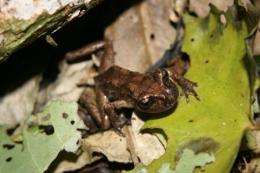Research reveals old timers in the frog world

Research at Victoria University has revealed remarkable longevity in wild populations of New Zealand native frogs, particularly in the threatened Maud Island frog (Leiopelma pakeka).
A study by Associate Professor Ben Bell and his team over the past 25 years shows that the three oldest known Maud Island frogs are two males reaching at least 35 and 37 years, and a female at least 34 years old.
Associate Professor Bell says this is one of the longest running field studies on any frog, and Maud Island frogs have proven to be some of the oldest known frogs in the wild.
"What I thought might be a five year study is still ongoing, with many frogs surviving over 25 years. We also studied Archey's frog and Hochstetter's frog in the Coromandel Ranges, and discovered these species are long-lived also. Our oldest known Archey's frog is 23 years old, and Hochstetter's frog is 12 years old."
Associate Professor Bell is Director of Victoria University's Centre for Biodiversity and Restoration Ecology, and his study of Archey's frog in the Coromandel Ranges alerted conservation agencies to the species' sudden decline in the late 1990s. His team discovered that the species was infected with the pathological amphibian chytrid fungus there.
Back on Maud Island there has been no major decline in frogs, although the research team continues to monitor population trends and to test for the occurrence of the chytrid fungus. Rigorous quarantine measures are taken by the Department of Conservation and by frog researchers to reduce risks of disease striking the population.
Associate Professor Bell says all the Maud Island frog skin swab samples they have DNA tested for amphibian chytrid fungus proved negative, but they will remain vigilant.
He says the team also initiated a trial translocation of 100 frogs to a restored site at Boat Bay on Maud Island 25 years ago, which had proven successful.
He has also collaborated with Associate Professor Shirley Pledger from Victoria's School of Mathematics, Statistics and Operations Research to determine population trends and survival rates of native frogs.
He works with Karori Wildlife Sanctuary in establishing Maud Island frog populations there. Eleven froglets that bred in the Sanctuary were successfully reared to the small frog stage at Victoria University last year, before being returned to the Sanctuary. Ten more young were discovered this year, and will be returned to the Sanctuary after completing their development at Victoria University. The research team also found three tiny frogs that had just completed their development on Maud Island this March, suggesting that breeding occurs there in early summer, as in the Karori Wildlife Sanctuary.
Provided by Victoria University
Provided by Victoria University of Wellington
















